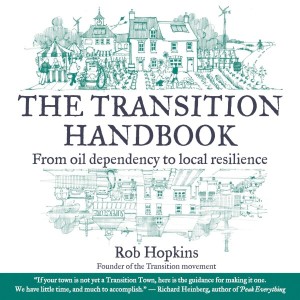The Transition movement is about communities stepping up to address the big challenges they face by starting local. Challenges most of us face include reliance on fossil fuels, climate change, and the economic crisis, but every community is different. There are over 1,000 Transition initiatives in the world and 160 in the USA.
How it began
Permaculture students (the ones who took Rob Hopkins’ class in 2004 in Kinsdale, Ireland) got Transition rolling. They saw the movie “The End of Suburbia” one day and then heard Dr. Colin Campbell (Association for the Study of Peak Oil) say that the double whammy of climate change/peak oil and the economic recession required immediate action.
Many scientists agree that 350 parts per million of carbon dioxide in the atmosphere is the maximum formula for a healthy planet. In 2005, the ppm had climbed to 370, continuing the ascent as a result of global warming. Now, in 2015, it has crested 400, with no stop in sight.
What came about in the Kinsdale, Ireland permaculture class, was a plan (outlined in Rob Hopkin’s The Transition Handbook) to put local communities in charge of their own destiny.
There are four (4) key assumptions underlying Transition.
- “That life with dramatically lower energy consumption is inevitable, and that it’s better to plan for it than to be taken by surprise;
- “That our settlements and communities presently lack the resilience to enable them to weather the severe energy shocks that will accompany peak oil;
- “That we have to act collectively, and we have to act now;
- “That by unleashing the collective genius of those around us to creatively and proactively design out energy descent; we can build ways of living that are more connected, more enriching and that recognize the biological limits of the planet.”
Twelve ingredients or steps are recommended to community groups who wish to set up a Transition in their city.
- Set up a steering group and design its demise from the outset;
- Raise awareness about the impact of climate change;
- Lay the foundations & groundwork for Transition to be successful;
- Organize a Great Unleashing, an inaugural event;
- Form groups (health, water, gardens, transport);
- Use Open Space;
- Develop visible practical manifestations of the project;
- Facilitate the Great Reskilling;
- Build a Bridge to local government;
- Honor the elders;
- Let it go where it wants to go; and
- Create an Energy Descent Plan.

